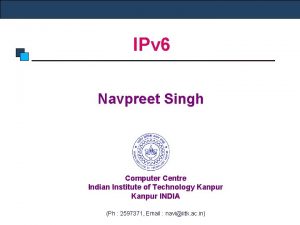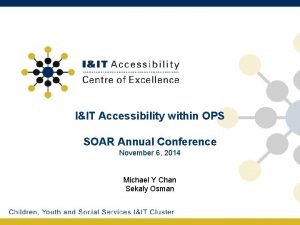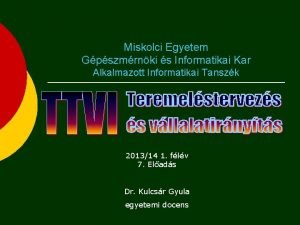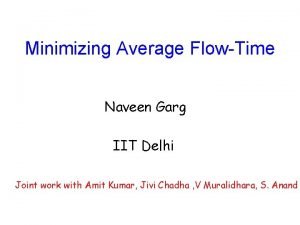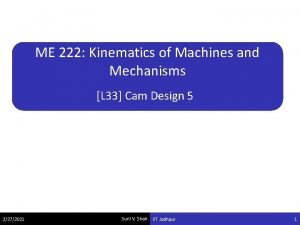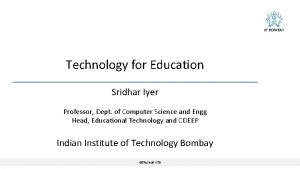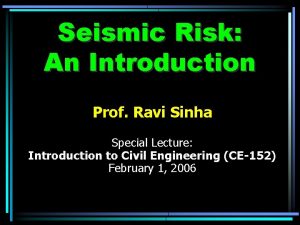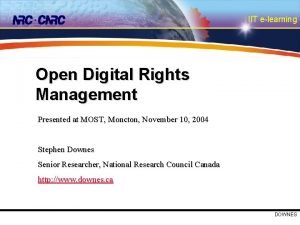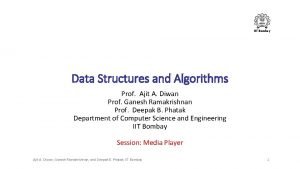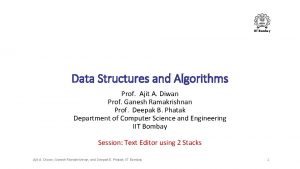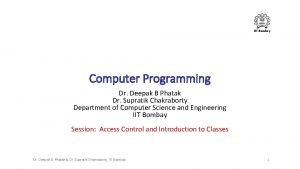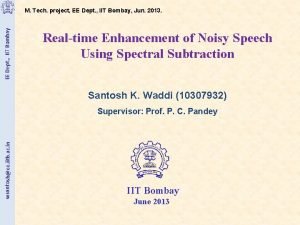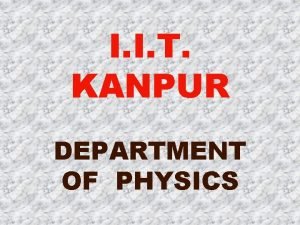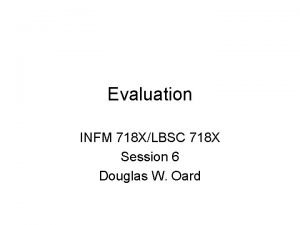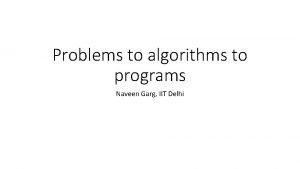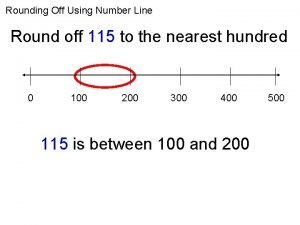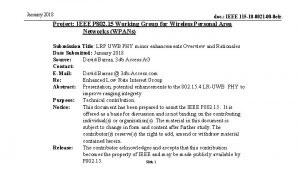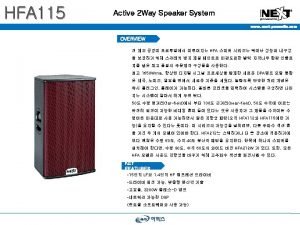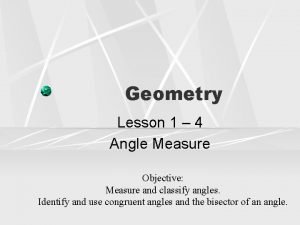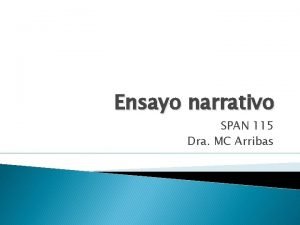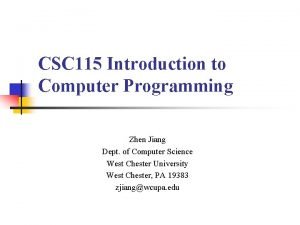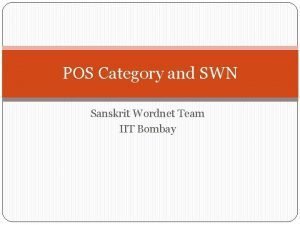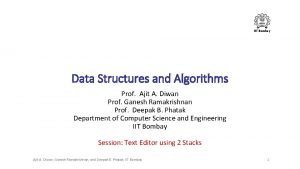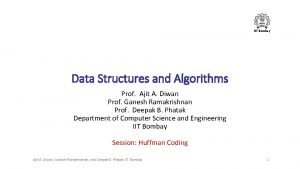Welcome to IIT and cs 115 CS 115






































![Variable Initialization public class My. Program { public static void main( String [ ] Variable Initialization public class My. Program { public static void main( String [ ]](https://slidetodoc.com/presentation_image_h/77aac3197a300b6d7c43e3c8f38a2b9f/image-39.jpg)






![Named Constants public class My. Program { public static void main( String [ ] Named Constants public class My. Program { public static void main( String [ ]](https://slidetodoc.com/presentation_image_h/77aac3197a300b6d7c43e3c8f38a2b9f/image-46.jpg)










- Slides: 56

Welcome to IIT and cs 115!

CS 115 - Sec. • Jon Hanrath - 214 SB • Office Hours: – TBD. • hanrath@iit. edu • www. cs. iit. edu/~cs 115 hanrath

• Lecture: TBD • Lab: TBD Lab assignments are due by the end of class in lab each week

CS Intro Courses • CS 105: 1 -Semester Requiring Little or No Previous Programming Experience, Programming in C++ • CS 115 -116: 2 -Semester Sequence Assuming Previous Programming Experience, Programming in JAVA, Primarily CS Majors • CS 201: 1 -Semester Sequence Equivalent of CS 105 -CS 106, Requires Previous Programming Experience, Programming in JAVA

CS 115 – Required Textbook and Lab Manual • “Java 6 Illuminated: An Active Learning Approach” Anderson and Franceschi • Second (Orange) OR Third (Purple) Edition

CS 115 - Quizzes/Exams & Grading • 2 Quizzes – Each 5% of Grade • 2 Exams: – Exam I - Lecture Exam - 10% – Exam II – Lecture - 20% • Final Exam - 30% • Labs - 20% • Project - 10% • Must Take Final to Pass Course • Final Grade: – – A > 90% B 80 -89. 99% C 70 – 79. 99% D 60 – 69. 99%

CS 115 Labs • Labs Assigned in Handout; on Website • Lab Exercises Comprised of Exercises and Programming Exercises (Located at End of Each Chapter in Textbook) • Student Expected to Complete Labs *BEFORE* Lab Section Meets • Labs Graded Either 10 (fully completed), 5 (partially completed), or 0 (not completed) • TA Will Cover Labs/Questions/Other Topics in Lab Session • Save. java File(s) to flash drive, or send to yourself in email and Bring to Lab Section for Discussion and Questions • Hand in assignments by end of lab to TA

Expectations • • • Attendance in Lectures and Labs Completion of Quizzes and Exams Four to Six Hours per Week on Homework Outside Help If Necessary No Cheating Have fun!!

Rules • No Swearing or Other Inconsiderate Behavior • Turn Off Cell Phones, i. Pads, Laptops • Questions, Discussion, Ideas Welcome

Excuses • If You Will Miss an Exam or Quiz, Make Arrangements **BEFORE** the Exam or Quiz Date • Exam, Quiz Dates Already Posted • If Emergency: – Doctor/Hospital Note – Family Problem: Contact Info for Parents

Unacceptable Excuses • • Slept Late Felt Sick I’m Just a Freshman Roommate Ate My Alarm Clock/Textbook/Underwear Missed Bus Had a Game/Match/Practice Didn’t Know When Exam/Quiz Was If Any of Above Happen, Get to Class As SOON as Possible!!!

CS 115 - Ethics • Exams: – Closed Book, Closed Notes, Closed Everything – Nothing in Ears (mp 3 players, cell phones, etc. ) • Labs Should Be Done Independently

CS 115 – Where to Get Help • www. cs. iit. edu/~cs 115 hanrath • Internet: Search for “JAVA tutorial”, or “JAVA help” • GET HELP EARLY RATHER THAN LATER!!!

CS 115 – Web Page • http: //www. cs. iit. edu/~cs 115 hanrath • Click on Syllabus – Weekly Assignments – Quiz and Exam Dates – Lecture Slides – Other Course Information

Course Philosophy • Computer Science Side – Problem Solving – Logical Thought – Programming in JAVA • “Real World” Side – Human Nature – Corporate World – Surviving during and after College

Problem Solving • CS 115 Develops Logic Skills to Solve Problems by Writing a Program • A Program is a Problem Solving Tool • Computers Follow Instructions Given to Them • Computers Do Not Have “Intuition” • Computers Do Not Make Decisions “on Their Own”

Problem Solving • • Arrange a Deck of Cards by Suit and Rank How Would You Do This? How Would You Tell a Child to Do This? How Would You Tell a Computer to Do This?

Why Use a Program? • Computers Perform Tasks Many Times Faster than a Person • Computers Are More Consistent than a Person • Computers Can Work 24 -7

Terminology • Source Code: the Original Problem-Solving, Logical Solution Written in a Programming Language (e. g. JAVA, . java file) • Interpretation: Converting source code into common language (. class file) • Compiling: the Action of Turning the Source Code into a Format the Computer Can Use • Linking: the Action of Bringing in Already Written Code (Libraries) for Use in a New Program • Executable: the Result of Compiling and Linking a Source Program; the “. exe” file that the Computer Can Run

JAVA Required Elements • Every JAVA Program Must Have: public class My. Program { public static void main( String [ ] args) { } }

Your First Program // Jon Hanrath // CS 115 // Section 042 public class My. Program { public static void main( String [ ] args) { System. out. println(“Hello World!!”); System. exit(0); } }

If You Missed Monday • Go to Course Website: – http: //www. cs. iit. edu/~cs 115 hanrath – Click on Syllabus, Click on Lecture Notes • Email TA to Complete Lab 0

Real Life Programs • Customer/Client/Organization Produces Specification (i. e. , problem to be solved) • Design Team Creates Solution Code – Pseudocode (“Fake Code”) – Design takes ~75% of Total Program/Solution Time • Design Team hands Solution to Programmers (Coders) • Programmers hand Program to Testers

What Is Pseudocode? • Every Programmer’s Way of Writing Down Steps in Solving a Problem • Steps in Creating Pseudocode: – Understand the Problem – Decide How to Solve the Problem – Write the Solution Using a Logical Sequence of Statements • Design Issues Apply to almost ANY Vocation

Compiler • Converts Source Code into an Object File or Machine Code • Each Change to Source File Requires a Recompilation • Compiler Detects Syntax Errors • Syntax Error: a Non-Proper, Not Allowable, Sequence of Characters or Words Given a Particular Language

Syntax Errors • Spelling Errors Examples: – Undefined Variable Name – Unrecognized Keyword • Punctuation Errors Examples: – Missing Curly Braces – Missing Semicolons – Malformed Comments • Syntax Errors Are Listed at Bottom of Screen When Compilation Is Complete

Syntax Errors (Cont) • Syntax Errors Are Listed at Bottom of Screen When Compilation Is Completed • First Error in Program May “Cause” Other Errors to Show Up • General Rule: Fix First Error (and Any Obvious Errors); Then Recompile

Logic Errors – “Bugs” • Also Called Semantic or Run-Time Errors • Program Compiles, but Doesn’t Produce the Expected Results • Examples: – – – Program Keeps Running Forever (Infinite Loop) Nothing Happens Program Output Is Incorrect Error Message at Run Time (e. g. Dividing by 0) Errors May Be Intermittent • May Be Able to Find Semantic Problems with Debugger

Detecting “Bugs” • Running Program Should Be Tested Several Times with Different Inputs • Test Plan – Series of tests (e. g. , inputs) that have predetermined expected outputs. • Running Program Should Be Tested Several Times under All Potential Conditions • When Errors Detected: Analysis Needed: Debugging Mechanism

Test Plan • What should the Test Plan contain for a program that accepts numerical input from a user, and outputs the square of the input?

JAVA Packages/Libraries • • • Over 2000 Libraries Exist Sometimes Called “Packages” Java. lang Package Automatically Imported Import Statements Above First Class Import Others with import statement import java. util. * //import all classes

Comments • Comments: Describe a Program • // Comment to end of line • /* Comment until first occurrence of star slash */ • Difficult to Understate Importance of Good Comments • Should Be at Beginning of Program (Overall Summary) • Should Be Next to Variable Declaration Briefly Describing Uses of Variable • Should Be Anywhere in Program Where Unobvious Coding Is Performed

Program Format • White Space: – Not Recognized by Compiler – Indent (e. g. 3 Spaces) for Each New Function, Selection, or Loop

Variables • Identifiers Used to Store Values that May Change • Every Variable Has a Type : What Kind of Value (e. g. , Integer, Floating Point Number, Character) Is Begin Stored • Every Variable Has a Value which Is Assigned and Can Be Changed • Every Variable Must Be Declared, which Sets Aside Memory for the Storage Location

Declaring a Variable • Declaration Normally Comes after a Function Definition Opening Curly Brace: • public class My. Program { public static void main( String [ ] args) { int num 1; //variable declaration num 1 = 10; // variable assignment // variable output below System. out. println(“num 1 is: ” + num 1); } } • Declaration Includes Type and the Name of the Variable • All Variables Must Be Declared before Being Used

Variables and Main Memory int num; Main Memory num <garbage> num = 10; num 10 num = 15; num 15

Main Memory • • • Storage Location of Data in a Computer Used When a Program Is Running “Wiped Clean” When Computer Rebooted Bit: A “ 1 or 0” representing “on or off” Byte: Basic Unit of Storage (Can Store One Letter of the Alphabet or Keyboard) (8 bits – 256 combinations) • Kilobyte (KB): 1000 (or 1024) Bytes (Pages of Text) • Megabyte (MB): 1, 000 Bytes (Large Pictures) • Gigabyte (GB): 1, 000, 000 Bytes (Music Files, Video Files)

Initialization and Assignment • Initialization: Value Given to Variable at Declaration • Assignment: Value Given to Variable in Execution Statement
![Variable Initialization public class My Program public static void main String Variable Initialization public class My. Program { public static void main( String [ ]](https://slidetodoc.com/presentation_image_h/77aac3197a300b6d7c43e3c8f38a2b9f/image-39.jpg)
Variable Initialization public class My. Program { public static void main( String [ ] args) { int num 1 = 10; //variable initialization System. out. println(“num 1 is: ” + num 1); } }

Announcements • Quiz 1 Next Monday

Built-In (or Primitive) Data Types for Variables • int: Integer Range of Typically – 2, 147, 483, 648 to 2, 147, 483, 647 (machine and compiler dependent) • float: Real Number (i. e. , integer part, decimal part, and exponent part) Range of Typically (+/-) 10 e-45 to 10 e 38 • double: Larger Real Number ((+/-) 10 e-324 to 10 e 308) • char: Character

Naming Variables in JAVA: Identifiers • Can Use Letters: Remember That JAVA is Case Sensitive (e. g. , Num. Widgets Is Not the Same as numwidgets) • • Can Use Digits 0 -9, $, and Underscore Cannot Start with a Digit Cannot Contain Spaces or Other Characters Cannot Use JAVA Keywords

Naming Variables (Cont) • Should Use a Meaningful, Descriptive Name so that Variable’s Use Is Easily Understood: • Examples: counter, second, minute, length, width • Be Consistent with Case; Usually Lower Case with Upper Case for Second Part of Variable Name • Examples: average. Rainfall, total. Student. Grades, max. Building. Height, min. Package. Weight;

Named Constants • Constant: An Identifier that Is Initialized to a Value that Cannot Change • Usually Declared at Top of Program using Keyword final • Standard Naming of Constants Is to Use All Upper Case Letter with or without Underscore between Words • All Constants Should Be Initialized • Syntax: final int MAXHT = 100;

Advantages of Constants • Easier to Understand • Easier to Modify • Example: Compare using Number 100 in Program versus Constant MAXHT
![Named Constants public class My Program public static void main String Named Constants public class My. Program { public static void main( String [ ]](https://slidetodoc.com/presentation_image_h/77aac3197a300b6d7c43e3c8f38a2b9f/image-46.jpg)
Named Constants public class My. Program { public static void main( String [ ] args) { final int MAXHT = 100; . . . current. Height > MAXHT. . . bridge. Height == MAXHT. . . bridge. Height + new. Addition >= MAXHT. . . } // used MAXHT 223 times in this program }

Literal Constants (Values) • Constants Whose values Are Already Known: Characters (Specified Inside Single Quotes): ‘A’ , ‘a’ , ’ 5’ , ’ ‘ , ’n’ (newline) , ’�’ (NULL Character) Integers: 10, 1345, -34 Float or Double: 2. 3, -45. 18, 10. 6 e 6 String (Specified Inside Double Quotes): “HELLO” , “What a great deal. ” , “ 5”

Input and Output • Also Known as I/O • Output : System. out. println(“Hello World!!”); • Input (Scanner): import java. util. Scanner; Scanner scan = new Scanner(System. in); scan. next. Int(); scan. next. Float(); scan. next. Double(); scan. next(); //String to whitespace scan. next. Line(); // String to end of line • All Wait until User Inputs Particular Type

Input and Output Example import java. util. Scanner; public class My. Program { public static void main( String [ ] args) { Scanner scan = new Scanner(System. in); int num. Entered; System. out. print(“Enter an integer: ”); /// The following waits until user hits Enter num. Entered = scan. next. Int(); System. out. println(“You entered: “ + num. Entered); } }

Characters and Strings • Strings in java. lang package • Java. lang imported automatically

JAVA Strings • Declaration: String your. Name; • Assigning a Value to a String: your. Name = “A. Goose”; • String Constants (Values) Must Be Enclosed in Double Quotes

Input String Example import java. util. Scanner; public class My. Program { public static void main( String [ ] args) { Scanner scan = new Scanner(System. in); String lastname; System. out. print(“Enter last name: ”); lastname = scan. next(); System. out. println(“You entered: “ + lastname); } }

Expressions • Expression: A Sequence of One or More Identifiers and Operators that Evaluates to a Value • Operator: A Symbol Expressing a Way to Modify a Value or Values (e. g. , + for Addition) • Operand: A Value Being Modified by an Operator • Example Expressions: 5 current. Height + 10

Arithmetic Expressions • Standard Arithmetic Operations Can Be Performed: Addition, Subtraction, Multiplication, Division • Standard Arithmetic Operators Can Be Used for These Operations: +, -, *, / • Others: % - “Modulo (Mod)” – Remainder after Integer Division -- Decrement (Subtract 1) ++ Increment (Add 1)

Order of Operations • Precedence: Level of Importance of Operations Multiplicative Operators Have Higher Precedence than Additive Operators: *, /, % Higher +, - Lower • Associativity: Order of Operation for Equal Level Precedence Most Operators Have Left-to-Right Associativity Use Parentheses to Force Differing Precedence of Operations

Know for the Quiz • All Terms (Underlined Items) • Variable Declaration, Initialization, and Assignment • Constant Declaration • Expressions • Operators • Input (Scanner) and Output (System. out) • Everything in Homework through Lab 2
 Wise men three clever are we
Wise men three clever are we Professor ajit diwan
Professor ajit diwan Material science iit delhi
Material science iit delhi Vlab iit kharagpur
Vlab iit kharagpur Ajit diwan iitb
Ajit diwan iitb Iit health and wellness
Iit health and wellness Huzur saran iit delhi
Huzur saran iit delhi Total iit in india
Total iit in india Iit coaching in jaipur
Iit coaching in jaipur Top 10 iit coaching in india
Top 10 iit coaching in india Iit coaching in agra
Iit coaching in agra Origence coaching varanasi
Origence coaching varanasi Rajeev srivastava iit bhu
Rajeev srivastava iit bhu Iit miskolc
Iit miskolc Bme iit
Bme iit Navpreet singh iit kanpur
Navpreet singh iit kanpur Iit general counsel
Iit general counsel Soar iit
Soar iit Shweta agarwal iit madras
Shweta agarwal iit madras Msu iit thesis format
Msu iit thesis format Bahni ray iit delhi
Bahni ray iit delhi Iit kanpur wind tunnel
Iit kanpur wind tunnel Iit miskolc
Iit miskolc Naveen garg iit delhi
Naveen garg iit delhi Mekila 222
Mekila 222 Sridhar iyer iit bombay
Sridhar iyer iit bombay Graduate academic affairs iit
Graduate academic affairs iit Cs 105 iit
Cs 105 iit Jon hanrath
Jon hanrath Ravi sinha iit bombay
Ravi sinha iit bombay Ashok kumar pandey iit hyderabad
Ashok kumar pandey iit hyderabad Iit
Iit Iit elearning
Iit elearning Iit
Iit Iit
Iit Iit
Iit Deepak phatak
Deepak phatak Iit
Iit Iit
Iit Debasis roy iit kgp
Debasis roy iit kgp Nss iit delhi
Nss iit delhi Iit kanpur physics faculty
Iit kanpur physics faculty Iit-cdip
Iit-cdip Work pmv
Work pmv Naveen garg iit delhi
Naveen garg iit delhi Designing learner-centric moocs
Designing learner-centric moocs Arti kashyap iit mandi
Arti kashyap iit mandi Mira mitra iit kgp
Mira mitra iit kgp Rounding with a number line
Rounding with a number line Non pas a nous mais a ton nom
Non pas a nous mais a ton nom Hpd 135 uitm
Hpd 135 uitm Ieee 115
Ieee 115 Next hfa 115
Next hfa 115 Interior point geometry
Interior point geometry Texto narrativo es
Texto narrativo es Csc 115
Csc 115 Psalm 23 gnt
Psalm 23 gnt















